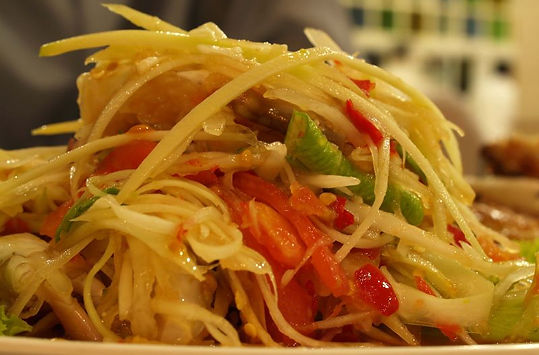Must-Try Dishes in Laos
Lao cuisine is very similar to its Thai and Vietnamese neighbour’s culinary offerings. Spicy soup, sticky rice and a range of meat-based side dishes make up a meal, shared by all at the table.

Khao Niaw -
Laos Sticky Rice
The foundation of all Laos meals, most Laos prefer sticky rice to regular steamed white rice. In fact, they eat on average 345 pounds of it per person annually, more than any other country. Sticky rice takes longer to digest than regular white rice, so people can go longer without eating, important in an agragarian society like Laos. Expect to see a small woven basket of it at every meal. The rice is rolled by hand into small balls, dipped into food and sauces like jeow, a dry, non-oily chili paste with a bit of buffalo skin mixed in, and eaten with the fingers.

Larb - Laos Meat Salad
Probably the best-known Lao dish, larb is a chopped meat “salad” made of pork, chicken, beef, duck or fish, dressed with lime juice, garlic, crushed, roasted rice and herbs and served at room temperature.
The protein used in larb can be raw or cooked. Traditionally, village hunters brought in game. The meat was divided among the community, and with no way to store fresh meat, it was eaten immediately. Popular raw larb variations include fish (the lime juice “cooking” it like a ceviche) and duck (with blood). Diners at restaurants will most likely be offered the cooked version, though.

Tam Mak Houng -
Papaya Salad
This salad you can find in Thailand or in Vietnam. But it is saltier and grittier with mainly spicy and salty notes, thanks to the bpadek, or fermented fish sauce. The Lao version of fish sauce is made from mud fish, and the resulting product is not the clear amber color travelers have come to know from Thai or Vietnamese cuisine, but a dark, thick, opaque, gritty (sometimes chunky) liquid whose strong flavor may be an acquired taste.

Oh Lam - Stew
Originating from the Hmong of Luang Prabang, oh lam is a stew mainly made from vegetables: beans, eggplants, gourds, black mushrooms, then seasoned with lemongrass, chili, and coriander and finally thickened with sticky rice. Ho or Oh is loosely translated as “to put in”, which implies that this stew is a hodge podge of whatever ingredients are on hand. But the key ingredient is sa kan, a bitter root herb.


